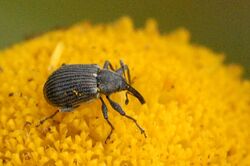Biology:Anthonomus rubi
| Strawberry blossom weevil | |
|---|---|

| |
| Scientific classification | |
| Domain: | Eukaryota |
| Kingdom: | Animalia |
| Phylum: | Arthropoda |
| Class: | Insecta |
| Order: | Coleoptera |
| Infraorder: | Cucujiformia |
| Family: | Curculionidae |
| Subfamily: | Curculioninae |
| Genus: | Anthonomus |
| Species: | A. rubi
|
| Binomial name | |
| Anthonomus rubi (Herbst, 1795)
| |
| Synonyms[1] | |
| |
Anthonomus rubi, the strawberry-blossom weevil or strawberry blossom weevil, is a species of weevil found in Europe and western Asia.[1][2][3] It feeds on plants of the family Rosaceae and is an important pest of strawberry (Fragaria × ananassa Duchesne) and raspberry (Rubus idaeus L.). This insect is a particularly problematic pest of strawberry in Europe, in some cases responsible for up to 80% loss of the berry crop.[4]
Ecology and description
Adults are 2–4 mm (0.079–0.157 in) long and dull black, covered with a fine grey pubescence. The larvae are 3–3.5 mm (0.12–0.14 in) long, curved, and white with brown head. Adults feed on strawberry foliage, and females lay eggs inside unopened flower buds (one egg per bud) before partially or totally severing the stalk;[5] larvae develop inside the severed buds, feeding on the wilting tissue.
Role of pheromones
Adults are thought to be attracted to strawberries by chemicals released by the plants. Monoterpenes, sesquiterpenes, and aromatic compounds acted as odorants (attractors) on weevils' receptor neurons.[6] Male A. rubi then release their own blend of aggregation pheromone, three components of which have been shown to attract weevils to baited traps.[2]
See also
- Anthonomus signatus (Strawberry bud weevil)
References
- ↑ 1.0 1.1 "Anthonomus (Anthonomus) rubi (Herbst, 1795)". Fauna Europaea. Fauna Europaea Secretariat, Museum für Naturkunde, Berlin. https://fauna-eu.org/cdm_dataportal/taxon/c03e9652-5a48-4145-b3fa-f07349a3022d.
- ↑ 2.0 2.1 Innocenzi, P. J.; Hall, D. R.; Cross, J. V. (2001). "Components of male aggregation pheromone of strawberry blossom weevil, Anthonomus rubi Herbst. (Coleoptera: Curculionidae)". Journal of Chemical Ecology 27 (6): 1203–1218. doi:10.1023/A:1010320130073. PMID 11504023.
- ↑ "Anthonomus rubi L.Bedel, 1887". Species. GBIF. http://www.gbif.org/species/1196192.
- ↑ Popov, S.Ya. (1996). "Possibility of monitoring the population density of the strawberry blossom weevil, Anthonomus rubi Herbst (Coleoptera, Curculionidae), on strawberry by two methods: counting clipped buds and using pheromones". Entomological Review 75: 104–109.
- ↑ "Strawberry blossom weevil". Encyclopédie des ravageurs européens. Institut national de la recherche agronomique (INRA). https://www7.inra.fr/hyppz/RAVAGEUR/6antrub.htm. Retrieved 28 July 2021.
- ↑ Helena Bichão; Anna-Karin Borg-Karlson; Jorge Araújo; Hanna Mustaparta (2005). "Five types of olfactory receptor neurons in the strawberry blossom weevil Anthonomus rubi: selective responses to inducible host-plant volatiles". Chemical Senses 30 (2): 153–170. doi:10.1093/chemse/bji012. PMID 15703335.
Wikidata ☰ Q1348959 entry
 |

